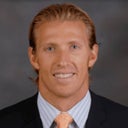This anatomic area is complex and not always easy or straightforward for either making assessments or treatment.
